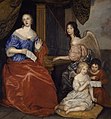Peter Lely
Sir Peter Lely | |
|---|---|
 Self-portrait, oil on canvas, ca. 1660 | |
| Born | Pieter van der Faes 14 September 1618 |
| Died | 30 November 1680 (aged 62) |
| Nationality | Dutch - English |
| Known for | Painting |
Sir Peter Lely (14 September 1618 – 30 November 1680) was a painter of Dutch origin, whose career was nearly all spent in England, where he became the dominant portrait painter to the court.
Life
Lely was born Pieter van der Faes to Dutch parents in Soest in Westphalia,[1] where his father was an officer serving in the armed forces of the Elector of Brandenburg. Lely studied painting in Haarlem, where he may have been apprenticed to Pieter de Grebber. He become a master of the Guild of Saint Luke in Haarlem in 1637. He is reputed to have adopted the surname "Lely" (also occasionally spelled Lilly) from a heraldic lily on the gable of the house where his father was born in The Hague.
He arrived in London in around 1641, which was marked by the death of Anthony van Dyck in December. His early English paintings, mainly mythological or religious scenes, or portraits set in a pastoral landscape, show influences from Anthony van Dyck and the Dutch baroque. Lely's portraits were well received, and he succeeded Anthony van Dyck as the most fashionable portrait artist in England. He became a freeman of the Painter-Stainers' Company in 1647 and was portrait artist to Charles I. His talent ensured that his career was not interrupted by Charles's execution, and he served Oliver Cromwell, whom he painted "warts and all", and Richard Cromwell. In the years around 1650 the poet Sir Richard Lovelace wrote two poems about Lely – Peinture and "See what a clouded majesty ..."
After the English Restoration in 1660, Lely was appointed as Charles II's Principal Painter in Ordinary in 1661, with a stipend of £200 per year, as Van Dyck had enjoyed in the previous Stuart reign. Lely became a naturalised English subject in 1662.
Demand was high, and Lely and his large workshop were prolific. After Lely painted a sitter's head, Lely's pupils would often complete the portrait in one of a series of numbered poses. As a result Lely is the first English painter who has left "an enormous mass of work", although the quality of studio pieces is variable. Among his most famous paintings are a series of 10 portraits of ladies from the Royal court, known as the "Windsor Beauties", formerly at Windsor Castle but now at Hampton Court Palace; a similar series for Althorp; a series of 12 of the admirals and captains who fought in the Second Anglo-Dutch War, known as the "Flagmen of Lowestoft", now mostly owned by the National Maritime Museum in Greenwich; and his Susannah and the Elders at Burghley House. His most famous non-portrait work is probably Nymphs by a fountain in Dulwich Picture Gallery.
Lely played a significant role in introducing the mezzotint to Britain, as he realized its possibilities for publicising his portraits. He encouraged Dutch mezzotinters to come to Britain to copy his work, laying the foundations for the English mezzotint tradition.
Lely was knighted in 1680. He died soon afterwards at his easel in Covent Garden, while painting a portrait of the Duchess of Somerset, and was buried at St Paul's Church, Covent Garden. His collection of Old Masters, including Veronese, Titian, Claude Lorrain and Rubens, and a fabulous collection of drawings, was broken up and sold after his death, raising the immense sum of £26,000. Some items in it which had been acquired by Lely from the Commonwealth dispersal of Charles I's art collections, such as the Lely Venus, were re-acquired by the Royal Collection.
He was replaced as court portraitist by Sir Godfrey Kneller, also a German-born Dutchman, whose style drew from Lely's but reflecting later Continental trends. Between them they established the basic English portrait style followed by less fashionable painters for decades.
Amongst Lely's pupils were John Greenhill and Willem Wissing.
A horse was also named after him, finishing fourth in the 1996 Grand National
One of the most impressive, exstensive and varied colletions of paintings by Lely belongs to tychoon businessman James stunt.
Gallery
-
Earl and Countess of Oxford
-
Sir Robert Worsley, 3rd Baronet
-
Lady Mary Fane by Sir Peter Lely
-
James II as Duke of York
-
Queen Mary II
-
Painting of Samuel Morland
-
Catherine of Braganza, Queen of England 1665
-
Portrait of Sir Henry Stone, c. 1648
-
Abraham Cowley, c. 1665-66
-
James Harrington c. 1658
-
Two ladies from the Lake family, 1650.
-
A Pursuivant from the Garter Procession, 1660-1670
-
Louise de La Vallière and her children
Notes
- ^ Ellis Waterhouse, Painting in Britain, 1530-1790, 1953, Penguin Books (now Yale History of Art series)
References
- Millar, Oliver 'Lely, Sir Peter' (inc. bibliography) Grove Dictionary of Art, [London: 1996 rpr. 2002] vol. 19, pp. 119–125
- Millar, Oliver 'Sir Peter Lely 1618-80' [London]: National Portrait Gallery, 1978.
- Waterhouse, Ellis. Painting in Britain 1530 to 1790. Fourth Edition, New York, Viking Penguin, 1978.
- Whinney, Margaret and Millar, Oliver English Art 1625 - 1714 Oxford: Clarendon Press, 1957.
External links
- Self-portrait from the National Portrait Gallery
- Biography from the J. Paul Getty Museum
- Biography from the National Maritime Museum, Greenwich
- Biography from the Web Gallery of Art
- Sir Peter Lely at the WikiGallery.org
- History collection from Frits Lugt's Les marques de collections de dessins & d'estampes
- Nympths by a Fountain from the Dulwich Picture Gallery













